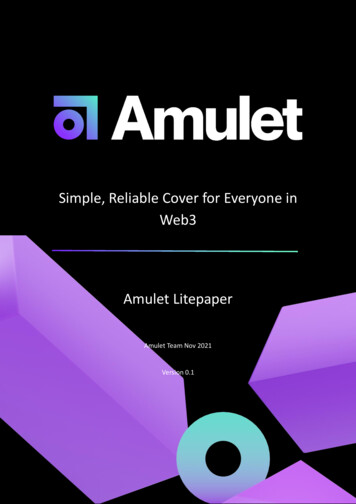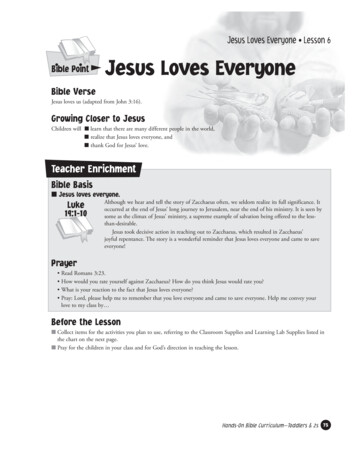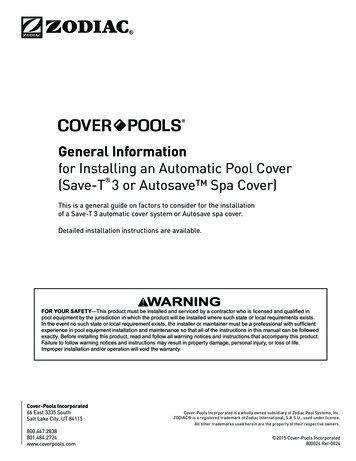
Transcription
Simple, Reliable Cover for Everyone inWeb3Amulet LitepaperAmulet Team Nov 2021Version 0.1
Table of Contents1.About this document . 32.Executive Summary . 33.Introduction . 43.1. The Opportunity . 43.2 Existing Challenges . 54.Platform Design . 64.1 Solution Overview . 64.2 Underwriting Tokens and Structure . 84.2.1 Amulet SOL ( amtSOL) . 84.2.2 Underwriting Token ( aUWT) . 94.2.3 Underwriting Structure . 94.3 Cover Products . 94.3.1 Product Offerings . 94.3.2 Pricing Model . 104.3.3 Cover Acceleration Program . 104.4 Capital and Risk Management . 114.4.1 Capital Model . 114.4.2 Risk Management. 124.5 Claim Process . 134.4.1 Programmatic Claims . 134.4.2 Voting-based Claims . 135Protocol Controlled Underwriting . 145.1 Key Design Thoughts . 155.2 Treasury Pool . 155.3 Yield Backed Claim Payout . 165.4 Phased Execution Path . 166. Cross-Chain Expansion . 177. Tokenomics . 187.1 Token Distribution . 187.2 Token Value Accrual . 188. Conclusion . 20Amulet Litepaper2 / 20
1. About this documentThis document and any other document in association aims to outline the businessconcept and platform design for Amulet Protocol, a decentralized cover protocoldesigned for the Rust-based ecosystems starting with Solana.The business proposal set out in this document is based on the prospect of the evolvingdigital era Amulet envisages, as well as certain assumptions and information currentlyavailable and deemed reliable to us, subject to updates. Due to the nascent nature ofDeFi, the views stated in this document are solely representative of the business ideasof Amulet's team, and do not constitute any investment suggestion to any digital asset,or explanation of the policies or opinions of any government or authority. Referencesto certain specific industry terms, company names, or platform trademarks, are forillustrative purposes only, and do not imply any affiliation with, or endorsement of anyof those parties.2. Executive SummaryAmulet Protocol (hereafter referred to as "Amulet") is a decentralized cover protocolbuilt for the Rust-based ecosystem, starting with the Solana blockchain. Amulet hasdesigned an innovative and open cover model, which not only effectively addressesthe common challenges of existing decentralized cover protocols, but also creates anew paradigm shift for the whole cover industry.Risk underwriting and claims lie at the core of any cover business; however, all existingdecentralized finance (DeFi) cover protocols have been facing a critical sustainabilitychallenge for risk underwriting and claims.Amulet is creating the industry’s first Protocol-Controlled Underwriting (PCU)approach, in which Amulet will build up its own underwriting capabilities andintroduce a claim structure involving a unique Yield Backed Claim (YBC) method. Thisis a significant deviation from the incumbent model of renting underwriting capabilityfrom capital providers to a more sustainable underwriting and claim structurecontrolled by the protocol.The vision of Amulet is to offer simple, reliable cover for everyone in Web3. With theaddition of Amulet, users in the entire Rust-based ecosystem will gain access to a newway to hedge various risks with cover product offerings.Amulet Litepaper3 / 20
3. Introduction3.1. The OpportunityDeFi has been unstoppable since the summer of 2020, with Total Value Locked (TVL)growing 27x from 9.7B in Sept 2020 to 261.2B as of writing. With the growing marketsize, the demand for risk hedging is also experiencing its own growth phase.Crypto users often suffer loss from various threats, such as security hacks to smartcontracts, stablecoin de-peg, market volatility, etc. In 2021, security hacks alonecaused over 3B in losses. Among all risk hedging tools, protection by way of cover hasbecome the most prominent and effective approach to managing these risks.Although Amulet has seen an increasing demand for cover products, currently lessthan 2% of overall DeFi TVL is covered. There is still a large coverage void, creating theneed for more cover protocols.Despite Ethereum and its affiliated EVM (Ethereum Virtual Machine) ecosystems’domination in DeFi, other Rust-based public chains are rapidly maturing, spearheadedby Solana. According to Amulet's research, TVL on Solana is growing 5x faster thanEthereum, and this growth is expected to be stronger given the distinctive strengths ofSolana centered around lower cost, higher throughput, and strong potential for Web3.Figure 1 Ecosystem TVL GrowthSolana’s rise as a major layer 1 solution brings with it the promise of an alternate realmof possibilities. The broader Rust-based ecosystem is now 30B in size. While there hasbeen tremendously positive ecosystem growth and top-tier talent brought into thespace, this growth also opens up increased risk of attacks and bad actors.Amulet foresees the demand for cover and other risk management solutions on Solana,and the broader Rust-based ecosystems to soon experience its own boom. However,cover availability is still non-existent on Solana and scarce on the Rust-based space.This presents a unique blue ocean opportunity that Amulet will service immediately toaddress increasing market demand for safety.Amulet Litepaper4 / 20
3.2 Existing ChallengesThere are several notable challenges for existing decentralized cover protocols thatconfines the sustainability and growth of the protocol:a. Capital and User AcquisitionCover protocols are faced with a two-pronged problem of acquiring and retainingstaked capital. There is inherent risk of losing principal while at the same time,intense competition for user capital across a high APY environment. Yieldfluctuations alone can cause liquidity locusts to form, causing many protocols tobe at the mercy of their stakers and forcing some to increase rewards to simplyretain staked capital. This does not appear to be a sustainable solution and couldresult in a debt spiral that becomes more and more difficult to emerge from overtime.b. Network BuildingBuilding up distribution channels to increase coverage and capacity whilemaintaining appropriate risk control is difficult. The importance of having strongnetworks cannot be stated strongly enough for cover protocols. Their businessand operating model is fundamentally that of a conduit for collective risk poolingand mutual aid. Oftentimes, having cover is an afterthought that occurs once auser or protocol has been rugged, hacked or somehow exploited even thoughthese risks are known ahead of time. Investors and protocols that have cover canbe liberated from some of these risks and delve deeper into their crypto journeysin a safe manner. Although it is an uphill battle to educate users and futurepartners on proactive risk management, the team building Amulet believes it is aworthy cause to champion.c. Capital ManagementIn the event of a catastrophic claim, stakers could race to withdraw funds tominimize impacts on their principal. While understandable from the underwriters’perspective, this creates a potential threat to the protocol’s sustainability. Until aprotocol reaches its critical mass and can pay for incoming claims with coverpayments and associated investment earnings, that threat will remain present.Without an effective risk management framework, it becomes difficult tounderstand whether risks are priced effectively, and capital is well-allocated toprotect against these “bank run” scenarios.d. Claims ProcessingIt is difficult to ensure a trustworthy, impartial claim process with reasonable cost,whilst aligning the interests of different parties on claims. For example,underwriters are incentivized to minimize payouts since they are paid based onthe overall profitability (cover payments received less claims paid); however,claimants want to minimize cover payments and increase their potential payout.Satisfying these two parties already poses several challenges withoutconsideration for investors, community members, the impact on partner andcover protocols' reputation.Amulet Litepaper5 / 20
Apart from the common challenges listed above, the deepest challenges to existingDeFi cover protocols lie in their underwriting and claims models. All existing coverprotocols build their underwriting capacity by renting liquidity from stakedparticipants and draw claim payouts directly from this rented underwriting pool. Thisimposes heavy liquidity challenges in the event of claims, placing the protocol on anunsustainable path. The existence and understanding of these problems led toAmulet’s innovations.4. Platform Design4.1 Solution OverviewThe design of a cover protocol normally entails balancing several core componentsincluding:-Risk Underwriting: how to acquire assets to properly underwrite risks.-Product Offering and Distribution: what types of risk are covered, how todefine and price them, and how to distribute the products to users.-Claims: how to decide on the claim result and handle claim payouts.-Capital Management: how to manage capital on the platform to maintainsufficient reserves.-Tokenomics: how to create and distribute value to token holders.There are many other factors to consider in this design, which will be covered brieflyin the following sections. Meanwhile, Amulet will use Solana as the ecosystem toillustrate its designs in this paper as the mechanics are transferrable to other Rustbased ecosystems.At a high level, the core design for the above components is listed in table below.ComponentKey DesignRiskUnderwriting1. At the start of the platform, use staked assets fromparticipants as the primary underwriting source in aconservative manner while building up the treasury pool togrow Protocol-Controlled Underwriting Capacity (PCUC).Eventually, PCUC will be adopted as Amulet’s primaryunderwriting source.2. Accept SOL as a staking asset, mint amtSOL to users as ayield bearing token (similar to mSOL and other staked assetsin the ecosytem) and use Solana PoS staking as the base layerfor yield generation.3. To keep the platform open, also accept other SOL derivedtokens widely used in Solana ecosystem such as mSOL (fromAmulet Litepaper6 / 20
Marinade project), stSOL (from Lido project), etc.4. Mint aUWT as an intermediary underwriting token to unify SOL derived tokens ( amtSOL, mSOL, stSOL) to be usedfor underwriting cover products.5. Set up token trading pairs (e.g., amtSOL- SOL, amtSOL mSOL on Solana AMMs to enable trading and arbitrageProduct1. Offer a wide range of individual products to cover various riskOfferingandtypes, such as smart contract hacking for DeFi protocols,stablecoin de-peg for fiat-backed stablecoins and algorithmicDistributionstablecoins, custodian risk for central exchanges andcustodian entities, and expand to NFT, GameFi and Metaverseassets.2. Use dedicated pricing models for different products such asrisk assessment-driven approach for smart contract cover andeconomic simulations for stablecoin de-peg cover.3. Bespoke solutions for institutional users with B2B cover andservices.4. Build up product distribution network via partnerships, APIintegrations, referral programs, etc.Overall, Amulet aims to offer attractive products with reasonablepricing and provide easy user access to them.Claims1. Build a hybrid claim process, with automatic claim process forparameterized products, and voting-based claim process forother products.2. On claim payout, use a tiered payout structure with the YieldBacked Claim Pool (YBCP) as the first tranche, followed by theclaims reserve in the treasury pool before drawing down onthe common underwriting pool.3. The YBCP aims to minimize loss to underwriting assetsprovided by end users, thus maintaining existing TVL togenerate more yield and grow the PCUC.CapitalManagement1. Use Solvency Capital Requirement (SCR) to manage theminimum required reserve for potential claim payouts, andliquidity for user staking / unstaking.2. Build up the treasury pool from various sources (e.g. PoSstaking, premium sharing, and other fees).3. With a treasury pool in place, use it to build PCUC, conducttoken buy backs, liquidity provisioning, etc.TokenomicsAmulet Litepaper1. Issue governance token identified as AMT token, which can7 / 20
be used for protocol governance activities.2. The tokenomics are designed to distribute value to longestterm AMT token holders and create desired alignmentbetween protocol sustainability and token holder interests.Table 1 Core Design ThinkingAmulet’s design provides a high level of protection against capital drawdowns whilstdelivering earning potential for its participants. The path to bringing this program tofruition will be a gradual process, based on treasury growth alongside the buffersintended to support it. An overview of Amulet's structure can be seen below, and thekey designs as mentioned above are further illustrated in the subsequent sections.Figure 2 Platform Overall Design4.2 Underwriting Tokens and Structure4.2.1 Amulet SOL ( amtSOL)Within the Solana ecosystem, users are accustomed to seeing derivative SOL tokenslike mSOL developed by Marinade.finance, and stSOL developed by Lido.finance.These tokens are a significant innovation in DeFi since it allows users to not only sharein platform rewards, but also use the issued tokens on other platforms in the wholeecosystem as well.Amulet Litepaper8 / 20
Amulet intends to contribute to this cycle of high capital efficiency and build aprotective layer on top of the ecosystem’s foundation - the SOL token and the SolanaPoS cluster. The platform will accomplish this by issuing amtSOL when a user depositstheir SOL tokens. amtSOL is a yield bearing token similar to mSOL, which accrues with yield generatedby Solana PoS staking. Meanwhile, users will also have the option to stake amtSOLinto underwriting pools to underwrite cover products, earn cover payments and AMTrewards, or stake into the amtSOL staking pool to earn AMT rewards within theplatform. They can also use the amtSOL to participate in other protocols in the Solanaecosystem to earn additional yields.With the creation of amtSOL, Amulet will become interwoven into the Solanaecosystem.4.2.2 Underwriting Token ( aUWT)As an open DeFi cover protocol, Amulet also supports other SOL derived tokens suchas mSOL, stSOL, etc. to participate in underwriting.When amtSOL, mSOL, stSOL are used for underwriting cover, aUWT tokens areminted to unify the underwriting capabilities of these tokens. The SOL derived tokensare exchanged to aUWT token with a volume-weighted average algorithm.There will be trading pairs on DEXs (e.g. Saber or Raydium) for these tokens, Iing amtSOL- SOL, amtSOL- mSOL, amtSOL- stSOL, amtSOL- aUWT, mSOL- aUWTand stSOL- aUWT. Users can swap their original tokens from these protocols, or theycan redeem directly from Amulet.4.2.3 Underwriting StructureUnlike some existing cover protocols that are using a combination of commonunderwriting pools and individual pools for cover products, Amulet will use individualpools for each product, and users can choose one or multiple pools to underwrite bystaking their aUWT into specific product pools.There will be a leverage factor applied to limit underwriting capabilities for each aUWT, which is set at 1.5 in the beginning, and subject to subsequent governancedecisions.By providing underwriting capital, users will be eligible for premium sharing from thepools they choose to underwrite, and AMT tokens as extra rewards. For specificproduct pools, aUWT holders may receive additional token rewards from partnershipprojects who participate in the Cover Acceleration Program.4.3 Cover Products4.3.1 Product OfferingsAmulet builds with learnings from existing cover protocols and plans to cover a widespectrum of different risk types, like smart contract vulnerability, stablecoin de-pegrisk, custodian risk, etc. to begin with.Amulet Litepaper9 / 20
As the protocol grows, other solutions such as default risk for lending protocols, NFTasset risk, price volatility risk, etc. will be created.Apart from the individual products above, Amulet will also issue bundled covers andportfolio-based coverage, to provide lower cost and simplified user experiences.To enhance the user experience, cover operation functions including coverrecommendation, cancel, renewal, roll-over, extension, etc. will also be provided.In due time, Amulet's technologies will expand towards other Rust-based blockchains(e.g. Terra and Cosmos), delivering a valuable suite of products to a growing userbase.4.3.2 Pricing ModelThe cover business is an endeavor to hedge against uncertain future loss, in which thecovered person trades risk with cover protocols through cover payments paid on coverproducts. Cover product pricing lies at the core of any cover business, and Amuletbuilds its pricing model based on proven practices and historical data as well.In general, the aim of product pricing is to find a fair, affordable, competitive cost levelfor users, to reflect the current risks and be highly fluid in an ever-changing risk regime.These design features allow Amulet to estimate expected loss of cover products fairly,reduce costs, and enhance long-term sustainability.It also creates the need for multiple pricing models to account for various risks.For example, the typical pricing approach for Smart Contract Cover centers around arisk assessment on a DeFi protocol. This generates a basic risk rating from multipleperspectives including tech auditing reports, operation history, team background, etc.With the base risk rating, initial pricing can be amended to take into account cost(relative to protocol APY) and supply-demand factors. A typical approach could involvecreating a bonding curve between pricing and the cover capacity. The more capacity,the lower Amulet's pricing and vice-versa. This serves to drive user adoption, but alsouses capacity as a proxy for risk.Note: As an alternative method to bootstrap or replenish capacity and reduce costspaid by their end-users, the Cover Accelerator Program (CAP) has been developed forDeFi protocols and is described in the section below.As another example, pricing for stablecoin de-peg cover relies on economic simulationusing historical data to back-test and identify the initial parameters, followed by theincorporation of current market indicators and forward-looking assumptions. Amuletwill carefully select and define these parameters at the protocol’s initiation, followedby constant refinement as new data emerges.With more data accumulated on Amulet's protocol and the industry, moresophisticated data-driven pricing models can be developed, leveraging MachineLearning methodologies, to fine-tune and optimize the models and parameters overtime.4.3.3 Cover Acceleration ProgramIn order to bootstrap the underwriting capacity of certain products, and generatehigher returns for underwriting users, Amulet's CAP engages with covered projectteams to accelerate cover adoption. This mainly applies to smart contract cover forAmulet Litepaper10 / 20
DeFi protocols at Amulet’s initiation.For example, when smart contract cover for Protocol A is launched, the initial pricemight be set on the high end and capacity might be very small since underwriters donot have a strong incentive to back the risk. Protocol A can incentivize users by offeringtheir native tokens or other rewards, and Amulet can jointly sponsor AMT rewards aswell to provide an added underwriting boost. This results in increased cover capacityand lower costs while underwriters earn more rewards. Additionally, pool rewards thatProtocol A has designated for this underwriting program (that have yet to be paid) willserve as a risk buffer for claim events.This program presents a win on multiple fronts as protocols create more cover optionsfor their userbase, users are safely generating rewards and Amulet reaches a wideraudience.4.4 Capital and Risk Management4.4.1 Capital ModelAlthough Amulet is not an insurer, neither is it in the business of providing insurance,arranging insurance contracts, nor is it acting as an insurance agent, it is nonethelessappropriate and indeed desirable for Amulet to adopt the highest possible capitalmanagement standards available to manage its capital pools in the interest of theAmulet community. Amulet’s capital model will refer to EIOPA’s Solvency II regulations,a regulatory framework set out for insurance and reinsurance operators in the EU. Therequirements set out by Solvency II are designed to ensure adequate protection ofpolicyholders and beneficiaries.Solvency II is an economic risk-based approach that assesses the “overall solvency” ofinsurance and reinsurance undertakings through quantitative and qualitativemeasures. Under Solvency II, the capital requirements are determined based on riskprofiles and how such risks are managed, providing the right incentives for sound riskmanagement practices, and securing enhanced transparency.There are different tiers of capital requirements under Solvency II, of which theSolvency Capital Requirement (SCR) and Minimum Capital Requirement (MCR) arecritical criteria. The SCR is capital required to ensure that the company would be ableto meet its obligations over the next 12 months with a probability of at least 99.5%,while MCR represents the threshold to correspond to an 85% probability of adequacyover 12 months and is bound between 25% and 45% of the SCR. For supervisorypurposes, the SCR and MCR can be regarded as “soft” and “hard” floors.Amulet Litepaper11 / 20
Figure 3 SCR ExplainedThe SCR calculation runs on a regular basis, and all data are calculated on-chain andshown on Amulet's website. As Amulet becomes more decentralized, governancetoken holders will have a say in the required capital requirements to adjust to currentrisks. When the SCR reaches its limit, the whole underwriting pool will be locked toavoid liquidity risk, ensuring a minimum of required capital is maintained in theunderwriting pool.4.4.2 Risk ManagementRisk management in Amulet can be broken down into several key functions: Capital adequacy and managementSolvency II capital management requirements create a desired level of safetywhen underwriting user and protocol risks. Adherence to this standard builds aprotective moat around Amulet's capital base, ensuring that staked capital isprotected, and claim payout is reserved at a proper level. Layered risk controlsThere are a series of risk control procedures built into Amulet at different layers toensure the safety of funds and soundness of the business:- Technical measurements to ensure the safety of the protocol at the base level,including code auditing, bug bounty program, and rigorous continuous testing.- Risk assessment on protocols to avoid the high-risk ones.- Concentration risk identifiers at multiple levels, including individual productlevel, the risk type level, and public chain level to minimize the risk ofconcentrated breakout of catastrophic events on certain covers.Amulet Litepaper12 / 20
Emergency handling mechanism such as kill-switch to suspend all or partialbusiness activities on the platform to control suspicious behaviors.Firm contract language to identify the specific scope of conditions, whichwould lead to payout.On-chain risk alertsOn-chain data monitoring, analysis and alerting serve as valuable signals to coverprotocol operations, such as dynamically identifying security status of coveredprotocols, adjusting cover pricing, or responding to risk events. Amulet is workingwith projects in the industry who are building these tools to enhance its riskmonitoring capabilities.4.5 Claim ProcessAmulet aims to build a hybrid claim process to simplify and satisfy various productclaims. A programmatic claims process will be developed for parametric coverproducts and voting-based claim processes will be used for the non-parametricproducts.4.4.1 Programmatic ClaimsThis approach is suitable for the parameterized products like stablecoin de-peg coverswhere there are clear rulesets on whether the cover’s trigger event occurred. Theserules can be programmed and automatically executed if the cover is triggered toaccelerate the claims payment process and reduce the burden on users to supply proofof a claim. It will also serve to reduce the burden on resources required to determinethe validity of a claim from Amulet’s perspective.4.4.2 Voting-based ClaimsAlthough programmatic claim process is a technologically preferred approach, it is nota silver bullet for every product. Products such as custodian risk covers, and complexsmart contract exploits are not yet easily verifiable. A voting-based claims process willstill be needed in these circumstances.There are a few typical roles involved in this voting-based process including:1) The claimant who is seeking remuneration for a loss event that was triggered.2) The advisory board, consisting of team members, community representativesand third-party personnel (e.g. a DAO) with the required expertise toinvestigate the claim case, and file a reference report for voting. The advisoryboard is only responsible for dispute settlement if the voting process fails.3) The claims assessors, who stake AMT for claim assessment rewards, and veAMT holders (see section 4 for details) will work together to opine and voteon the legitimacy of the claim.4) Amulet will then pay the resultant claim set by these committees.Amulet Litepaper13 / 20
Alternatively, there are decentralized arbitration organizations (such as Kleros) activelydeveloping in the space, which can be an option for dispute settlement in Amulet'sclaim process as well.Note: As for the claim payout mechanism, refer to Section 4.3.With a mixture of both automated and manual claims processes, Amulet hopes touphold a standard of speed balanced with equality for its userbase.5 Protocol Controlled UnderwritingAs mentioned, existing DeFi cover protocols are all relying on capital providers(“underwriters”) to provide underwriting capacity and use this underwriting capital forclaim payouts directly. This is effectively the same as renting underwriting capabilitiesfrom stakers. This model is effective in the short to medium-term, but are facing a fewserious issues that may greatly impact the scalability and sustainability of coverprotocols. In the event of outsized claims, underwriters may race to withdraw theirunderwriting funds and lead to insufficient claim payouts, but it also has afurther devastating consequence of reduced TVL and future underwritingcapacity to recoup losses. Because of the concern for losing principal in underwriting, many users areunwilling to participate in cover protocols. These cover protocols will impose lockups on capital pools when claimshappen or other restrictions for stakers, however these controls are generallynot user friendly, and further hinder user participation. Yield generated from cover protocols are generally not as competitive
Amulet Litepaper 5 / 20 3.2 Existing Challenges There are several notable challenges for existing decentralized cover protocols that confines the sustainability and growth of the protocol: a. Capital and User Acquisition Cover protocols are faced with a two-pronged problem of acquiring and retaining











